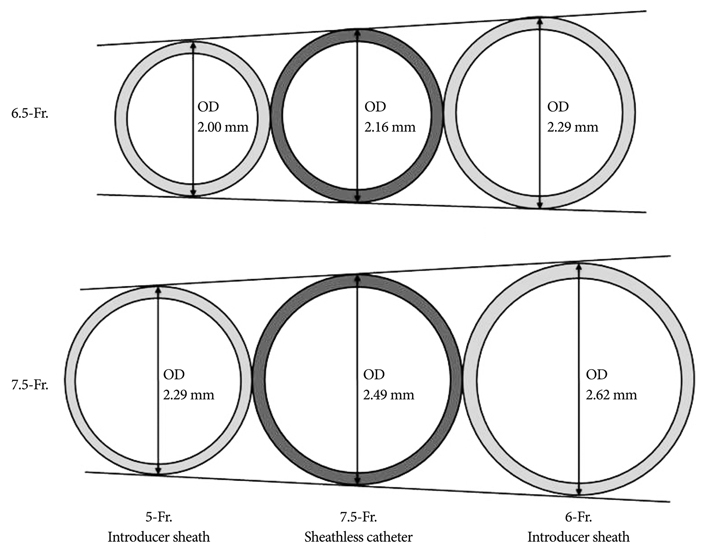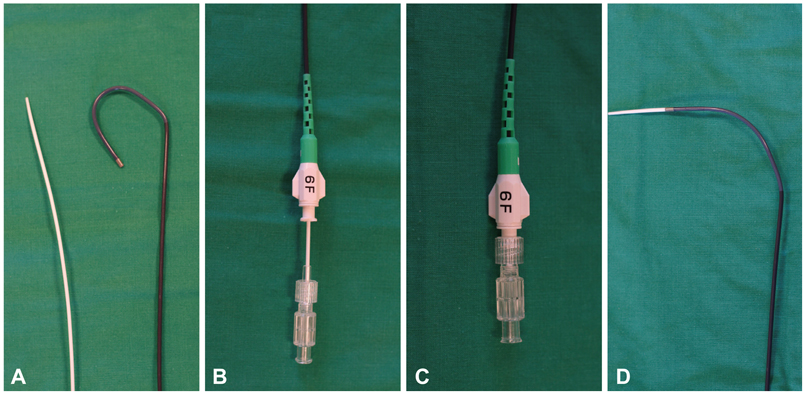Feasibility of Transradial Coronary Intervention Using a Sheathless Guiding Catheter in Patients With Small Radial Artery
- Affiliations
-
- 1Division of Cardiology, Wonju College of Medicine, Yonsei University, Wonju, Korea. jyoon@yonsei.ac.kr
- KMID: 2225128
- DOI: http://doi.org/10.4070/kcj.2011.41.3.143
Abstract
- BACKGROUND AND OBJECTIVES
Transradial coronary angiography and intervention are increasing in frequency due to lower major vascular access site complications and the potential for early mobilization. However, the small size of the radial artery (RA) is a major limitation of this technique. A sheathless guiding catheter (GC) has recently been introduced that has a 1-2 French smaller diameter compared with the corresponding introducer sheath. This catheter also has a hydrophilic coating along its entire length. We evaluated the feasibility of using a sheathless GC in patients who have small radial arteries.
SUBJECTS AND METHODS
The procedural results were evaluated in patients with small radial arteries (diameter <2.3 mm) who underwent transradial coronary intervention using a sheathless GC.
RESULTS
A total of 25 (male: 9) patients with 29 lesions were enrolled. The mean RA diameter was 1.81+/-0.26 mm. 44% of the patients had stable angina and 50.0% had acute coronary syndrome. The procedural success rate was 93.1%. Two patients (6.9%) had chronic total occlusive lesions that could not be crossed with a guide-wire despite good guiding support. An intravascular ultrasound could be used for all of the treated lesions. Multi-vessel intervention was performed in 29.2% of the patients. Two bifurcated lesions were treated with a kissing balloon technique, and one with a modified T-stenting technique. No catheter related complications were reported.
CONCLUSION
The use of a sheathless GC is feasible in patients with small radial arteries without catheter related complications.
MeSH Terms
Figure
Cited by 2 articles
-
Successful transradial intervention via a radial recurrent artery branch from the radioulnar alpha loop using a sheathless guiding catheter
Shin-Eui Yoon, Sangwook Park, Sung Gyun Ahn
Yeungnam Univ J Med. 2018;35(1):94-98. doi: 10.12701/yujm.2018.35.1.94.Transradial Versus Transfemoral Access for Bifurcation Percutaneous Coronary Intervention Using Second-Generation Drug-Eluting Stent
Jung-Hee Lee, Young Jin Youn, Ho Sung Jeon, Jun-Won Lee, Sung Gyun Ahn, Junghan Yoon, Hyeon-Cheol Gwon, Young Bin Song, Ki Hong Choi, Hyo-Soo Kim, Woo Jung Chun, Seung-Ho Hur, Chang-Wook Nam, Yun-Kyeong Cho, Seung Hwan Han, Seung-Woon Rha, In-Ho Chae, Jin-Ok Jeong, Jung Ho Heo, Do-Sun Lim, Jong-Seon Park, Myeong-Ki Hong, Joon-Hyung Doh, Kwang Soo Cha, Doo-Il Kim, Sang Yeub Lee, Kiyuk Chang, Byung-Hee Hwang, So-Yeon Choi, Myung Ho Jeong, Hyun-Jong Lee
J Korean Med Sci. 2024;39(10):e111. doi: 10.3346/jkms.2024.39.e111.
Reference
-
1. Jolly SS, Amlani S, Hamon M, Yusuf S, Mehta SR. Radial versus femoral access for coronary angiography or intervention and the impact on major bleeding and ischemic events: a systematic review and meta-analysis of randomized trials. Am Heart J. 2009. 157:132–140.2. Agostoni P, Biondi-Zoccai GG, de Benedictis ML, et al. Radial versus femoral approach for percutaneous coronary diagnostic and interventional procedures: systematic overview and interventional procedures. J Am Coll Cardiol. 2004. 44:349–356.3. Saito S, Ikei H, Hosokawa G, Tanaka S. Influence of the ratio between radial artery inner diameter and sheath outer diameter on radial artery flow after transradial coronary intervention. Catheter Cardiovasc Interv. 1999. 46:173–178.4. Kiemeneij F, Fraser D, Slagboom T, Laarman G, van der Wieken R. Hydrophilic coating aids radial sheath withdrawal and reduces patient discomfort following transradial coronary intervention: a randomized double-blind comparison of coated and uncoated sheaths. Catheter Cardiovasc Interv. 2003. 59:161–164.5. Yoo BS, Lee HH, Yoon J, et al. The study of branching anomaly and tortuosity of radial artery for trans-radial coronary procedure. Korean Circ J. 2000. 30:82–89.6. Mamas M, D'Souza S, Hendry C, et al. Use of the sheathless guide catheter during routine transradial percutaneous coronary intervention: a feasibility study. Catheter Cardiovasc Interv. 2010. 75:596–602.7. Mamas MA, Fath-Ordoubadi F, Fraser DG. Atraumatic complex transradial intervention using large bore sheathless guide catheter. Catheter Cardiovasc Interv. 2008. 72:357–364.8. Liang M, Puri A, Linder R. Transradial simultaneous kissing stenting (SKS) with SheathLess access. Catheter Cardiovasc Interv. 2010. 75:222–224.9. Cubero JM, Lombardo J, Pedrosa C, et al. Radial compression guided by mean artery pressure versus standard compression with a pneumatic device (RACOMAP). Catheter Cardiovasc Interv. 2009. 73:467–472.
- Full Text Links
- Actions
-
Cited
- CITED
-
- Close
- Share
- Similar articles
-
- A Case of Sheathless Transradial Coronary Intervention for Complex Coronary Lesions with a Standard Guiding Catheter
- Successful transradial intervention via a radial recurrent artery branch from the radioulnar alpha loop using a sheathless guiding catheter
- Simple Management of Radial Artery Perforation during Transradial Percutaneous Coronary Intervention
- Feasibility and Problems in Transradial Coronary Angiography and Intervention
- Radial artery access with a sheathless 0.087” inner diameter balloon guide catheter (Walrus) for neurointerventional procedures: Technique and clinical outcomes



